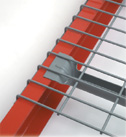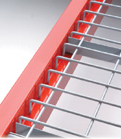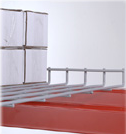
How to Select the Best Wire Deck for Your Storage Rack
Michael Thoma | 23 July 2014
1. Identify the Product(s) Being Stored
Understand the product you are wanting to store. Is it a box, a pallet, a container, or something else? This is a very critical step in determining a wire deck for your storage racking. You cannot simply choose a wire deck based on the advertised rated capacity. There are many factors that go into making a wire deck such as the wire size, grid pattern, the number of U channels, waterfall direction, and finish.
2. Provide Your Integrator with Product Dimensions
Make sure you provide your integrator the product type along with the overall dimensions and weights. It is key to note if the item will be point loaded (load weight is concentrated on specific points) or line loaded (load weight is concentrated in a line) on the wire decking. If there is point loading or line loading, be sure to note exactly where it will occur, so the wire deck can be sized appropriately in those areas. In most cases, the entire deck will be sized to accept the weight in any location.
3. Understand Your Racking Type
The next thing that an integrator will need to know is the detail of the industrial rack in which the wire deck will be placed on. More importantly the beams. There are two different types of beams out there:
- Roll formed beam – Created from a roll of steel; often less expensive; easily damaged
- Structural beam – Created from hot steel into I-beams or C-channels; often more expensive; more impact resistant; repairable
Knowing what type of beam you’re using will allow you to select a waterfall (see number 4).
4. Do You Need a Waterfall?
You might be asking yourself what the heck is a waterfall on a wire deck? A waterfall is basically the configuration of the wire deck. There are several different types of waterfalls.
- Standard Step, Outside Waterfall. This is one of the most common and is seen in most warehouses and manufacturing settings. The wire decks sits on a step beam and the wire overhangs both front and back beams by roughly 1.5”.

- Inverted Flange, Outside Waterfall. This is the same as above, however a structural beam is being used rather than a roll formed beam.

- Flush or Flush Flat. There is no outside waterfall. The wire deck is contained within the rack structure. Note: It is good practice to a tek-screw (screws that drill their own pilot hole) to secure the wire deck to the beam. This type of deck can only be used with a roll formed beam. It is most commonly found in hand stack and order picking applications.

- Non-Standard Waterfalls. It is possible to have an outside waterfall were the load side of the wire deck is pointing down and the back side of the wire decks wire is pointing up to act as a back stop. Again, it is recommended that the wire deck be tek-screwed to the beam.

5. Is the Environment Corrosive?
Next, you need to ask yourself if the wire deck will go into a corrosive environment. If so, you might consider getting a galvanized finish verses a painted finish. There are many finishes out there including oven baked enamel, powder coated, hot dipped galvanized, pre-galvanized, and electro-zinc plated finishes. If you need help determining any of these options or would like more information about choosing the right wire deck, please contact us on your next pallet racking or shelving project.
Comments
No comments have been posted to this Blog Post
Leave a Reply
Your email address will not be published.
Comment
Thank you for your comment.